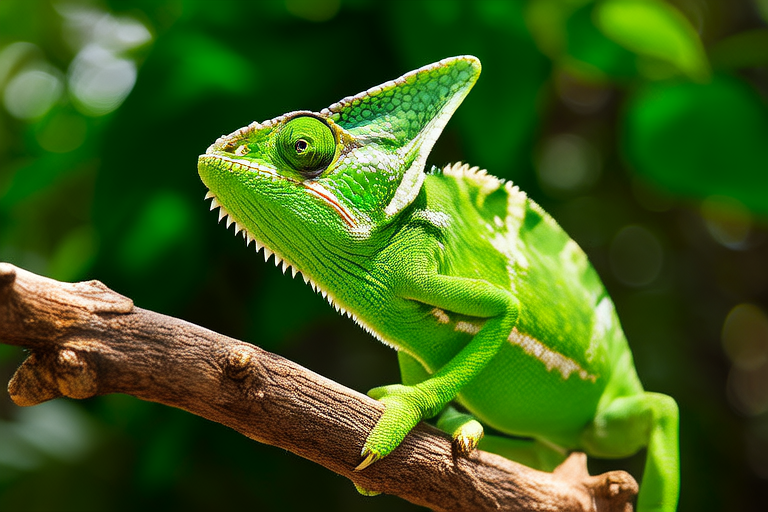Chameleon Care: Expert Tips for a Happy and Healthy Pet
Introduction to Chameleons as Pets
Chameleons have long been a fascination for many due to their unique ability to change color and their striking appearance. As pets, they offer a captivating experience that can enrich any home environment. However, owning a chameleon comes with significant responsibilities. These lizards are highly specialized creatures with specific needs regarding habitat, diet, and care. Before diving into the world of chameleon ownership, it’s crucial to understand the commitment involved.
Chameleons are native to Africa, Madagascar, and southern Europe. Their natural habitats vary from lush rainforests to arid deserts, which means different species have adapted to various environmental conditions. This diversity in origin underscores the importance of researching the particular species you plan to bring into your home, such as the Panther chameleon or Jackson’s chameleon.
Habitat Setup: Lighting, Temperature, Humidity, Enclosure Size
Lighting
Proper lighting is essential for chameleons’ health. They require both UVB and UVA light. UVB light helps them synthesize vitamin D3, which aids in calcium absorption. A 10% UVB bulb placed within 12-18 inches of the basking spot is recommended. The light should cover at least half of the enclosure. Additionally, UVA light contributes to their overall well-being by promoting natural behaviors.
Temperature
Maintaining the right temperature gradient is vital. Chameleons are ectothermic, meaning they rely on external sources to regulate their body temperature. The ideal temperature range for most species is between 75°F and 90°F (24°C-32°C). A basking spot should reach around 95°F (35°C) to allow them to thermoregulate effectively.
Humidity
Chameleons thrive in humid environments, but too much moisture can lead to respiratory infections. Aim for a humidity level between 50% and 70%. Use misting systems or foggers to achieve this, ensuring adequate ventilation to prevent stagnant air.
Enclosure Size
The enclosure must be spacious enough to accommodate climbing structures and provide ample space for movement. For adult chameleons, a minimum of 24″ x 24″ x 48″ (61cm x 61cm x 122cm) is advisable. Vertical space is more important than horizontal, allowing for natural climbing behavior.
Diet and Nutrition
Chameleons are insectivores, primarily consuming insects like crickets, dubia roaches, and mealworms. Variety is key; feeding different types of insects ensures a balanced diet. Gut loading insects with nutritious foods before feeding them to your chameleon enhances their nutritional value.
Vitamin and mineral supplementation is necessary. Dust insects with calcium powder twice a week and multivitamins once a week. Over-supplementation can be harmful, so follow guidelines carefully. Hydration is also critical; provide fresh water daily through misting or drip systems.
Handling Tips
Chameleons are delicate creatures and do not enjoy being handled. Frequent handling can cause stress, leading to health issues. When necessary, handle them gently, supporting their body fully. Avoid grabbing them by the tail, as this can result in tail loss. Regular interaction should focus on positive experiences, like gentle hand feeding or supervised time outside the enclosure under controlled conditions.
Common Health Issues
Metabolic Bone Disease (MBD) is a prevalent issue caused by calcium deficiency. Symptoms include weak limbs, lethargy, and difficulty moving. Ensuring proper calcium intake and UVB exposure can prevent MBD.
Respiratory infections may occur if humidity levels are incorrect. Signs include labored breathing, nasal discharge, and lethargy. Maintaining optimal humidity and temperature is crucial for preventing these infections.
Stress-related illnesses can manifest as reduced appetite, weight loss, and abnormal behavior. Providing a secure, enriched environment helps minimize stress.
Regular Care Routines
Cleanliness is paramount. Spot clean the enclosure daily to remove waste. Deep clean weekly, replacing substrate and thoroughly disinfecting all surfaces. Regular veterinary check-ups are also essential for early detection of health issues.
Monitoring your chameleon’s behavior and physical condition regularly allows for quick responses to potential problems. Pay attention to changes in appetite, activity levels, and appearance.
